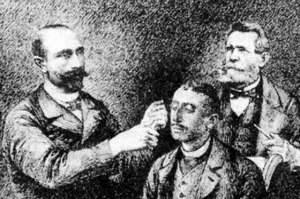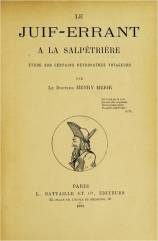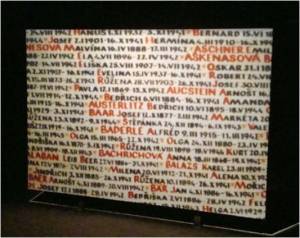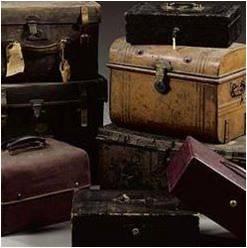(adapted from a paper given at ‘There & Back Again’, a postgraduate conference at the University of Nottingham, organised by the Landscape, Space, Place Research Group. The title is taken from Iain Hacking’s fascinating study of the fugueur phenomenon)
The idea of wandering, of travelling without constraints, without a humdrum practical purpose, is perennially appealing to most of us, even if, for most of us, the drawbacks come to mind pretty speedily if we start to entertain the notion. Some do it anyway – seize the moment when the obstacles are not insuperable – but generally it’s something to enjoy vicariously, or to indulge in short bursts, taking time out of a holiday schedule to just have a stroll around foreign streets.
Throughout myth and literature there are many wanderers who cross seas, continents and centuries. For some it’s a pastime, a means of avoiding commitments or encumbrance:
I’m the type of guy that likes to roam around
I’m never in one place, I roam from town to town
And when I find myself fallin’ for some girl
I hop right into that car of mine and ride around the world (Dion, The Wanderer, 1961)
Everyday in the week I’m in a different city
If I stay too long people try to pull me down
Hendrix suggests that the prejudices of the cities in which he finds himself push him to leave, as well as, like Dion, that if he does sometimes feel his heart ‘kinda gettin’ hot’ for some woman, he moves on before he gets caught. For some, wandering is a subversive practice (not using the city streets in the prescribed way), for others it’s a compulsion, even a curse.
The flâneur is one of those archetypal wanderers. This classic definition is by Baudelaire, writing in 1863 in his ‘Le Peintre de la vie moderne’.
The crowd is his element, as the air is that of birds and water of fishes. His passion and his profession are to become one flesh with the crowd. For the perfect flâneur, for the passionate spectator, it is an immense joy to set up house in the heart of the multitude, amid the ebb and flow of movement, in the midst of the fugitive and the infinite. To be away from home and yet to feel oneself everywhere at home; to see the world, to be at the centre of the world, and yet to remain hidden from the world—impartial natures which the tongue can but clumsily define. The spectator is a prince who everywhere rejoices in his incognito. The lover of life makes the whole world his family, just like the lover of the fair sex who builds up his family from all the beautiful women that he has ever found, or that are or are not—to be found; or the lover of pictures who lives in a magical society of dreams painted on canvas. Thus the lover of universal life enters into the crowd as though it were an immense reservoir of electrical energy. Or we might liken him to a mirror as vast as the crowd itself; or to a kaleidoscope gifted with consciousness, responding to each one of its movements and reproducing the multiplicity of life and the flickering grace of all the elements of life.
 He – and I use the masculine pronoun entirely deliberately – is ‘observateur, flâneur, philosophe, appelez-le comme vous voudrez’.
He – and I use the masculine pronoun entirely deliberately – is ‘observateur, flâneur, philosophe, appelez-le comme vous voudrez’.
He is a perfect stroller, a passionate spectator, an erudite wanderer. He walks the streets, probably alone, with no map or itinerary, with the confidence that comes from being male, well-educated and wealthy. His milieu is the city, and quintessentially Paris. One might think that the boulevards and arcades of Haussmann’s Paris lent themselves to strolling so much better than the labyrinthine streets of the old city, but it was that old city that defined the flâneur, allowing (in Edmund White’s words) ‘a passive surrender to the aleatory flux of the innumerable and surprising streets’.
The flâneur is a prototype detective, his apparent indolence masking intense watchfulness. This recalls Edgar Allen Poe’s story, ‘The Man of the Crowd’ (which was translated by Baudelaire), in which a man recovering from illness sits in a London coffee shop, watching the passers-by, and engaging in Holmesian deductions about their occupation and character. His attention is drawn by an old man who he is unable to read, and he feels compelled by insatiable curiosity to follow him, for a night and a day, as the man moves unceasingly through the city: he is the man of the crowd – not only hiding within it, but unable to exist outside it.
Walter Benjamin in his 1935 study of Baudelaire suggests that Baudelaire identifies the old man as a flâneur. This must be a misreading on Benjamin’s part, since the old man is as manic as the flâneur is composed. The flâneur may ‘set up house’ in the heart of the crowd, becoming part of ‘the ebb and flow of movement’, but he remains separate, above the mass. He is, like Baudelaire and Benjamin, at the same time engaged with and alienated by the city.
Poe’s story does give us a flâneur, however, in the person of the narrator, who can and does choose to abandon his pursuit, stepping aside to resume his life, and a different kind of wanderer, in the person of the man of the crowd. Steven Fink argues persuasively that the man of the crowd is the mythological figure of the Wandering Jew, condemned to wander endlessly as punishment for a terrible crime. (He has a number of counterparts, including, amongst others, Cain, the Flying Dutchman, and the Ancient Mariner.) Certainly this description by Benjamin’s contemporary, Siegfried Krakauer, is remarkably close to Poe’s description of the old man:
‘there arose confusedly and paradoxically within my mind, the ideas of vast mental power, of caution, of penuriousness, of avarice, of coolness, of malice, of bloodthirstiness, of triumph, of merriment, of excessive terror, of intense – of supreme despair … How wild a history … is written within that bosom!’. (Edgar Allen Poe, ‘The Man of the Crowd’)
Imagine [his face] to be many faces, each reflecting one of the periods which he traversed and all of them combining into ever new patterns as he restlessly and vainly tries on his wanderings to reconstruct out of the times that shaped him the one time he is doomed to incarnate. It is a terrible face, ‘assembled from the many faces of the dead’. (Siegfried Krakauer – History, the Last Things Before the Last (OUP, 1969))
If the man of the crowd is no flâneur, he does bear a stronger resemblance to the fugueur, a lesser-known (and shorter-lived) phenomenon which emerged in the 1880s. Bordeaux medical student Philippe Tissié and neurologist Jean-Martin Charcot at the Salpêtrière hospital in Paris documented a number of cases of men undertaking strange and unexpected trips, in states of obscured consciousness.  They were subject to hallucinations, and often dominated by ideas of persecution. Their conduct during the episode appeared normal, but they were unconscious of what they were doing, and had no memory of it afterwards – in a state of dissociative fugue. A fugue state is defined as involving selective memory loss, the inability to recall specific – perhaps traumatic – events. This may be accompanied by wandering and travelling, in an attempt to recover memory/identity, or perhaps in a flight from it – the etymological paradox of flight/pursuit.
They were subject to hallucinations, and often dominated by ideas of persecution. Their conduct during the episode appeared normal, but they were unconscious of what they were doing, and had no memory of it afterwards – in a state of dissociative fugue. A fugue state is defined as involving selective memory loss, the inability to recall specific – perhaps traumatic – events. This may be accompanied by wandering and travelling, in an attempt to recover memory/identity, or perhaps in a flight from it – the etymological paradox of flight/pursuit.
The fugueur is quite distinct from the flâneur whose journeying is deliberately aimless and random, an end in itself. His itinerary may defy linear logic but nonetheless is purposeful, even if that purpose can be discovered only retrospectively. The flâneur, in his fine clothes, walked the streets as if he owned them because, wealthy and well-educated, he could. The fugueur, in his state of obscured consciousness, was likely to be mistaken, instead, for a vagrant. Albert Dadas, ‘patient zero’ in the mini-epidemic of ‘mad travelling’, was repeatedly arrested for vagabondage. The fugueurs were generally of more modest means than the flâneurs – tradesmen, craftsmen or clerks – and their travels took them much further afield.  If someone spoke of a city or a country Albert was seized by the need to go there, and did so, often then finding himself in difficulties due to lack of funds.
If someone spoke of a city or a country Albert was seized by the need to go there, and did so, often then finding himself in difficulties due to lack of funds.
One of Charcot’s patients was a young Hungarian Jew named Klein, who was ‘constantly driven by an irresistible need to change his surroundings, to travel, without being able to settle down anywhere’. This particular patient prompted a link with the then prevailing view that Jews were more prone than other races to various forms of neurasthenia and that this particular manifestation was ‘in the character of their race’. Thus the Wandering Jew was, according to Henri Meige’s thesis, ‘only a sort of prototype of neurotic Israelites journeying throughout the world’. Even at the time it was pointed out, fairly acerbically, that if the Jews had a tendency to move from place to place, this was in generally externally rather than internally driven, as persecution and prejudice made it necessary to leave one home in search of another.
Charcot’s diagnosis, and his use of the term ‘hystero-epilepsy’ in particular, fell out of favour, largely due to the failure to identify a common cause that would account for a collection of rather disparate individual cases. In the twentieth century the two types of wanderer seem often to merge, as trauma and exile create a more melancholy and more driven wanderer. One can trace a line from Baudelaire’s flâneur to the Surrealists, via Walter Benjamin’s description of flânerie as a dream state in which ‘The city as a mnemonic for the lonely walker [: it] conjures up more than his childhood and youth, more than its own history’, to Guy Debord’s dérive as subversive practice, and on to today’s psychogeographers. Rather than being a disaffected and detached observer, the flâneur in the late 20th and 21st century may be in flight from memory, from identity, at home nowhere, an exile who feels no connection, or only a highly problematic one, to homeland or origins.
Michel Butor’s 1956 novel, L’Emploi du temps is set in a northern English industrial city, called Bleston but clearly inspired by Manchester, where Butor had worked a few years earlier. It takes the form of a diary kept by his protagonist, Jacques Revel, in the city for a one-year placement. We know nothing of Revel’s life before his arrival in Bleston, or of what he will do after he leaves. He speaks of his year there as a prison sentence – he is unable to leave the city during that period, and compelled to leave it on a specific date. He is certainly not at home in Bleston, but he seems entirely rootless, without any connection elsewhere. In his restless wanderings through the streets, he seems to be searching – mostly fruitlessly – for lodgings, for someone whose name he does not know who he met on an earlier walk, for the elusive countryside. But ultimately his quest is to master the city by walking its streets, grasping the reality which seems to be changing around him as he walks – it is a phantasmagorical city, whose heavily polluted atmosphere creates a narcotic dream-like state, distorting his perceptions and leaving him disorientated.
Butor’s novel had a significant influence on W G Sebald, who came to Manchester about 15 years later. Sebald read L’Emploi du temps when he first arrived, and it inspired a poem, ‘Bleston: A Mancunian Cantical’, as well as having a wider impact on his work.
In Sebald’s novels, the narrator (who may or may not be, to some extent, Sebald) invariably begins by describing a journey. He is precise about when, and where, although the layering of timeframes and locations means that we can lose these certainties as the narrative progresses, but frequently the ‘why’ is obscure, not just to the reader but to the narrator himself. The narrator and the various protagonists are rarely, if ever, ‘at home’. They are often in transit or in provisional, interim spaces such as waiting rooms, railway stations, and transport cafes. Their journeys often induce episodes of near paralysis, physical or mental, and they end inconclusively, often with a sense that the quest will continue after the final page.
But if the Sebaldian narrator is a contemporary example of the melancholy flâneur, Jacques Austerlitz connects us directly with the fugueur, and with wandering as a response to trauma and loss. As a child, Austerlitz arrived in England on the Kindertransport, where his foster parents gave him a new life, and a new name, telling him nothing of his past, or the fate of his parents, until, as a sixth former, he learns that he is not Dafydd Elias.
For many years he avoids any topic or image which might shed light on or raise questions about his origins. But, increasingly isolated, and with his life ‘clouded by unrelieved despair’, tormented by insomnia, he undertakes nocturnal wanderings through London, alone, outwards into the suburbs, and then back at dawn with the commuters into the city. These excursions begin to trigger hallucinations, visions from the past, for example, the impression that ‘the noises of the city were dying down around me and the traffic was flowing silently down the street, or as if someone had plucked me by the sleeve. And I would hear people behind my back speaking in a foreign tongue …’. He is irresistibly drawn to Liverpool Street Station, a place full of ghosts, built as it is on the remains of Bedlam hospital, and, in the disused Ladies’ Waiting Room, encounters the ghosts of his foster parents and the small boy he once was.
Thus his obsessive wanderings appear to have had a sub-conscious purpose, taking him back to the point of rupture between one life and another. He embarks upon a new phase of wandering, driven by the need to find his home and his parents. Overhearing a radio documentary about the Kindertransport, and the reference to a ship named The Prague, like Albert Dadas, the original fugueur: ‘the mere mention of the city’s name in the present context was enough to convince me that I would have to go there’.
Austerlitz’s quest remains incomplete at the end of the novel. In the course of his wanderings he has, he believes, discovered his former home in Prague and traced his mother to Teresienstadt and his father to the Gurs concentration camp in France in 1942. Beyond that he knows only that his mother ‘was sent east’ in 1944. He does not know where, when, or even whether they died.
His quest, and his confrontation with the losses that defined his life, leads to ‘several fainting fits … temporary but complete loss of memory, a condition described in psychiatric textbooks … as hysterical epilepsy’. He is taken, significantly, to the Salpêtrière, where Charcot established this diagnosis almost a century earlier. This diagnosis would only be included in psychiatric textbooks as a historical footnote – an example of Sebald’s dense or layered time – we know precisely where we are, but the ‘when’ is not so straightforward.
Thus we’ve come full circle. And I want to make another tentative, perhaps fanciful connection. Sebald invites us to make all sorts of links with the name Austerlitz – the battle, the Parisian railway station, even Fred Astaire. And there’s always the echo of another name, the likely final destination of both of his parents, unspoken here except in a reference to the Auschowitz Springs near Marienbad. One more then – Ahasuerus, the name often given to the mythological Wandering Jew.
Baudelaire’s description of the flâneur – ‘être hors de chez soi, et pourtant se sentir partout chez soi (away from home and yet at home everywhere)’ has echoed through the twentieth century and into our own, accumulating more and more melancholy baggage. That this phrase has darker undertones than Baudelaire will have intended is brought home by a speech made by Hitler in 1933, in which he described the Jewish people, the ‘small, rootless international clique’, as ‘the people who are at home both nowhere and everywhere’.
In our time then, rather than someone at ease wherever he finds himself, we are likely to think of the refugee and the exile, adapting without putting down roots, unable to return but unable fully to belong, always sub-consciously ready to move on or even keeping a bag permanently packed, just in case. For the original flâneur this characteristic was an affectation, a chosen detachment and rootlessness. For the fugueur, driven by trauma or crisis of identity, it is a curse, to have to wander, and never to find answers, or find home.
Anderson, George K, The Legend of the Wandering Jew (Hanover/London: Brown UP, 1991)
Benjamin, Walter, ed. Michael W Jennings, The Writer of Modern Life: Essays on Charles Baudelaire (Cambridge, MA/London: Belknap Press of Harvard UP, 2006)
Brunel, Pierre (ed), translated by Wendy Allatson et al, Companion to Literary Myths, Heroes and Archetypes (NY/London: Routledge, 1996)
Coverley, Merlin, Psychogeography (Harpenden: Pocket Essentials, 2006)
Fink, Steven, ‘Who is Poe’s Man of the Crowd?’, Poe Studies, 44, 2011 (17-38)
Gilloch, Graeme, Myth and Metropolis: Walter Benjamin and the City (Cam.: Polity, 1996)
Goldstein, Jan, ‘The Wandering Jew and the Problem of Psychiatric Anti-Semitism in Fin-de-Siècle France’, Journal of Contemporary History, 20, 4(October 1985), 521-52
Hacking, Ian, ‘Automatisme Ambulatoire: Fugue, Hysteria and Gender at the Turn of the Century’, Modernism/Modernity, 32 (1996), 31-43
__, ‘Les Alienés voyageurs: How Fugue Became a Medical Entity, History of Psychiatry, 7, 3 (September 1996), 425-49
__, Mad Travellers: Reflections on the Reality of Transient Mental Illnesses (Free Association Books, 1998)
Kuo, Michelle and Albert Wu, ‘Imperfect Strollers: Teju Cole, Ben Lerner, W G Sebald and the Alienated Cosmopolitan’, Los Angeles Review of Books, 2 February 2013
Lauster, Martina, ‘Walter Benjamin’s Myth of the Flâneur’, Modern Language Review, 102, 1 (January 2007), 139-56
McDonough, Tom, ‘The Crimes of the Flâneur’, October, 102 (2002), 101-22
Micale, Mark S, In the Mind of Modernism: Medicine, Psychology and the Cultural Arts in Europe and American, 1880-1940 (Stanford UP, 2004)
Seal, Bobby, ‘Baudelaire, Benjamin and the Birth of the Flâneur’, Psychogeographic Review, 14 November 2013
White, Edmund, The Flaneur: A Stroll through the Paradoxes of Paris (Bloomsbury, 2008)
www.artslant.com/la/articles/show/42145
http://www.thelemming.com/lemming/dissertation-web/home/flaneur.html
http://www.othervoices.org/1.1/gpeaker/Flaneur.php
http://imaginarymuseum.org/LPG/debordpsychogeo.jpg
http://www.paris-art.com/agenda-culturel-paris/Le%20Premier%20fugueur/Furaker-Johan/11840.html
http://www.karenstuke.de/?page_id=1192
https://dianajhale.wordpress.com/2013/11/01/tracing-sebald-and-austerlitz-in-londons-east-end/





#1 by fifepsychogeography on July 4, 2015 - 9:53 pm
Really enjoyed this – thanks.
LikeLike
#2 by cathannabel on July 5, 2015 - 10:03 am
Glad you liked it!
LikeLike